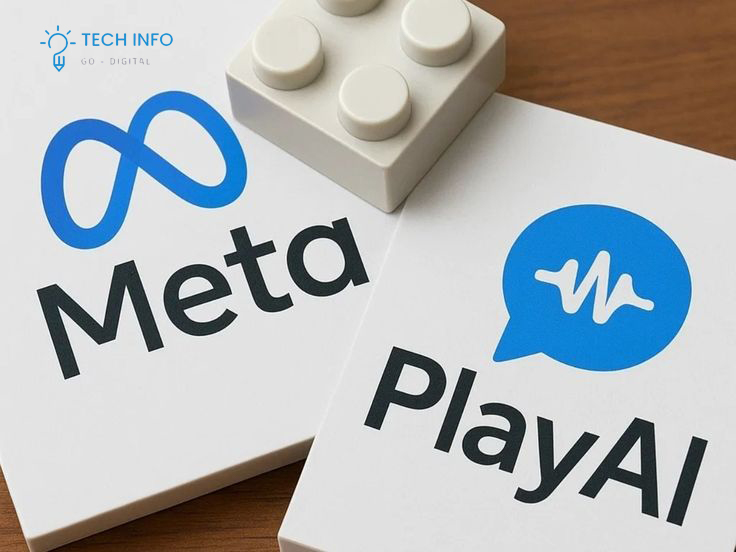Table of Contents
ToggleMeta Acquires AI Audio Startup WaveForms: A Strategic Leap in AI-Driven Sound Innovation

In the fast-moving world of artificial intelligence, sound technology is emerging as a key frontier. While Meta is already known for its ambitious plans in the metaverse, virtual reality (VR), and augmented reality (AR), this acquisition signals an intensified focus on sound as a central element of digital interaction.
The deal reflects Meta’s growing recognition that immersive audio experiences—from crystal-clear voice communication to lifelike spatial sound—are just as crucial as visuals in the digital environments it aims to build.
Who Is WaveForms?

The company has built a reputation for delivering studio-grade audio enhancements in real time, making it an attractive target for tech giants seeking to elevate the quality of online communication.
Key Innovations of WaveForms:
- AI-Powered Noise Cancellation – Filters unwanted sounds without distorting the speaker’s voice, even in chaotic environments.
- Advanced Voice Synthesis & Modulation – Generates natural-sounding synthetic voices and allows precise tone adjustments for personalization.
- Real-Time Audio Enhancement – Optimizes voice clarity over unstable or low-bandwidth internet connections.
- Spatial Audio Rendering – Creates 3D directional sound that mimics real-world acoustics, essential for VR/AR immersion.
WaveForms’ combination of AI, acoustics, and user-centric design makes it a natural fit for Meta’s long-term vision.
Why Did Meta Acquire WaveForms
Meta’s decision is driven by both strategic necessity and technological opportunity. The company’s road map for the next decade depends heavily on delivering realistic and engaging virtual spaces, whether in gaming, business meetings, or social experiences.
1. Strengthening the Metaverse Experience
The metaverse thrives on a sense of presence. Just as graphics deliver the visual realism, audio delivers emotional realism. WaveForms’ AI could allow Meta to create environments where sound feels as alive and responsive as the visuals—such as footsteps changing based on surface texture, or voices naturally shifting in volume and direction as avatars move.
2. Improving Communication Across Platforms
Meta owns Messenger, WhatsApp, Instagram, and Facebook, each with voice and video features. Integrating WaveForms’ noise suppression and enhancement tools could instantly improve call quality for billions of users worldwide.
3. Advancing AI Research at FAIR
Meta’s Facebook AI Research (FAIR) division is already exploring natural language processing, computer vision, and generative AI. Adding WaveForms’ expertise could open doors for hyper-realistic AI speech synthesis, instant voice translation, and smart audio filters.
4. Gaining a Competitive Edge
Rivals like Google, Apple, and Microsoft are investing in AI-driven audio—Google with AI music generation, Apple with adaptive AirPods audio, and Microsoft with Teams’ intelligent noise suppression. Meta’s move ensures it won’t lag behind in this competitive domain.
Potential Applications in Meta’s Ecosystem

WaveForms’ technologies could be deployed across ’s entire product line:
- VR & AR Immersion
- Meta Quest headsets could integrate AI-powered 3D audio to create more convincing virtual worlds.
- .
- AI Voice Assistants & Digital Avatars
- Avatars in Horizon Worlds could have unique, AI-generated voices rather than generic speech patterns.
- Content Creation Tools
- Instagram Reels and Facebook Stories could get automatic sound leveling, removing hiss or distortion.
- Creators could apply AI voice filters for stylistic effects without needing professional equipment.
- Accessibility Features
- Real-time speech-to-text improvements could make video calls more inclusive for hearing-impaired users.
- Automatic multi-language audio dubbing could help creators reach wider audiences.
How This Fits Meta’s Long-Term Vision
has made no secret of its aim to build a fully interconnected virtual economy and culture within the metaverse. But for users to feel truly present, sound must feel as authentic as a face-to-face conversation.
WaveForms can help solve existing challenges such as:
- Audio lag in live interactions.
- Inconsistent voice clarity in global low-bandwidth markets.
- Lack of realism in digital voice rendering.
By embedding AI audio into its infrastructure, Meta can bridge these gaps—making its virtual spaces more comfortable, intuitive, and believable.
Industry Reactions & Potential Challenges
Industry analysts have generally welcomed the acquisition, noting that AI-driven audio is becoming a critical competitive factor. They highlight the potential for to:
- Offer premium-quality audio in its apps without requiring extra hardware.
- Open new markets in virtual events, telemedicine, and online education.
However, the move is not without challenges:
- Ethical Concerns – AI voice synthesis could be abused for deepfake audio or impersonation.
- Privacy Issues – Real-time voice analysis may raise concerns about data collection.
- Regulatory Scrutiny – As with all major tech acquisitions, antitrust and data protection bodies may take interest.
Meta will need to demonstrate strong safeguards and transparent AI practices to address these concerns.
Future Outlook
The acquisition of WaveForms could lead to:
- Ultra-realistic metaverse gatherings where spatial audio makes virtual concerts or meetings indistinguishable from in-person events.
- Smarter AI translators that maintain emotional tone while converting speech between languages.
- Hyper-personalized voice assistants that adapt to a user’s preferences, mood, and environment.
If implemented correctly, these capabilities could redefine online communication—not just for Meta’s platforms, but as an industry benchmark.
: A Clear Signal in Meta’s AI Ambitions
s purchase of WaveForms is more than a routine startup acquisition—it’s a statement of intent. By investing in the future of AI-driven audio is preparing for a post-text, post-flat-screen era, where human-like voice interaction is a daily norm.
In the coming years, users can expect:
- Voice and video calls with near-studio sound quality.
- Virtual reality spaces where sound placement feels physically real.
- AI companions and avatars that speak as naturally as a friend.
The message is clear: Meta wants to own the soundscape of the digital future. With WaveForms in its arsenal, it’s well on its way





